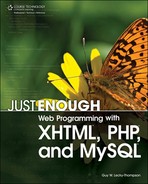Book Description
Just Enough Web Programming with XHTML, PHP, and MySQL provides a layperson's guide to web programming for the casual web designer, student, or serious professional. The book explains how to build powerful interactive sites, whether you're designing a bulletin board, game, or web store. As part of the Just Enough series, the book provides "just enough" information to get you started quickly, without overloading you with unnecessary details. After a brief introduction, the book concisely explains the XML, XHTML, and CSS concepts you need to understand to start creating web sites. From there, you'll start programming and learning the basics of client side and server side scripting and web databases. Then it's time to put it all together using Content Management Systems. The book includes several chapters on emerging Web 2.0 and how you can put it to use to create your own interactive sites quickly. Part of the beauty of Just Enough Web Programming with XHTML, PHP, and MySQL is its breadth of coverage. By cutting out what you don't need, the book helps you learn a lot about web programming, and helps you put all of the information together to make a site quickly. So what are you waiting for? Let's get started!
Book Description
Just Enough Web Programming with XHTML, PHP, and MySQL provides a layperson's guide to web programming for the casual web designer, student, or serious professional. The book explains how to build powerful interactive sites, whether you're designing a bulletin board, game, or web store. As part of the Just Enough series, the book provides "just enough" information to get you started quickly, without overloading you with unnecessary details. After a brief introduction, the book concisely explains the XML, XHTML, and CSS concepts you need to understand to start creating web sites. From there, you'll start programming and learning the basics of client side and server side scripting and web databases. Then it's time to put it all together using Content Management Systems. The book includes several chapters on emerging Web 2.0 and how you can put it to use to create your own interactive sites quickly. Part of the beauty of Just Enough Web Programming with XHTML, PHP, and MySQL is its breadth of coverage. By cutting out what you don't need, the book helps you learn a lot about web programming, and helps you put all of the information together to make a site quickly. So what are you waiting for? Let's get started!
Table of Contents
- Copyright
- Acknowledgments
- About the Author
- Introduction
- 1. Getting Started
- 2. Internet Recap
- 3. HTML, XML, and XHTML
- 4. CSS and Styles
- 5. Client Side Scripting
- Introduction to Client Side Scripts
- Introduction to JavaScript
- The JavaScript Web Function Library
- JavaScript Core Short Reference
- JavaScript Examples
- Recap
- 6. Server Side Scripting
- 7. Web Databases
- 8. Content Management Systems
- 9. Web 2.0 Features
- 10. Setting Up With Open Source
- 11. Web References
